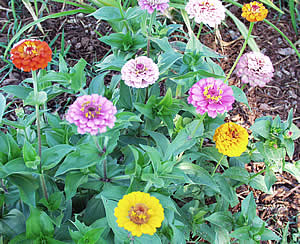Lovely Zinnias
 Originating in Mexico and South America, Zinnias are favorites in gardens here and abroad. These annuals are easy to grow and provide summer-long color in the garden. Members of the Daisy family, the zinnia comes in most every color except blue. The twenty-some species include plants that range in height from six inches to over three feet tall with blooms up to six inches across.
Originating in Mexico and South America, Zinnias are favorites in gardens here and abroad. These annuals are easy to grow and provide summer-long color in the garden. Members of the Daisy family, the zinnia comes in most every color except blue. The twenty-some species include plants that range in height from six inches to over three feet tall with blooms up to six inches across.
 Zinnias Then and Now
Zinnias Then and Now
Seeds of the Zinnia were sent back to Europe in the 1700s. Dr. Johann Gottfried Zinn wrote the first description of the flower, and thus it was named for him. Using Zinnia as a common garden annual didn’t occur until the late 1800’s when breeding took place in Holland, Italy, and Germany. The Zinnia became very popular when Bodger Seeds Ltd. introduced new varieties in the 1920’s.
With the development of even more types of Zinnia over the past eighty years, the flower has become a garden standard, Zinnia elegans being the most common variety. In 1999 the Sakata See Corporation introduced and was honored for the “Profusion” zinnias. This new type is a cross between Zinnia angustiflolia and Zinnia elegans, with great characteristics of both: heat tolerance, disease resistance, humidity tolerance, and no deadheading of blooms needed.
 Growing Zinnias
Growing Zinnias
Zinnias can be grown from seed indoors or directly in the garden. If starting seeds indoors, do so 4-6 weeks before planting outside, around the same time you’d plant peppers. Keep soil moist until seeds germinate. Thin plants to correct spacing when they have two pairs of leaves. Remove unwanted plants carefully if you’d like to transplant them elsewhere in your garden as Zinnias don’t like their roots to be disturbed.
Zinnias love sun, heat, and good air circulation. They need some water, of course, but are somewhat drought tolerant. In extreme heat, they appreciate some shade. When watering, try to water at the base, as wet leaves can lead to diseased plants. Fertilize twice during blooming season. Deadhead spent blooms to keep the flowers coming and pinch of the top of each plant to encourage branching (unless you want single blooms for cutting).






